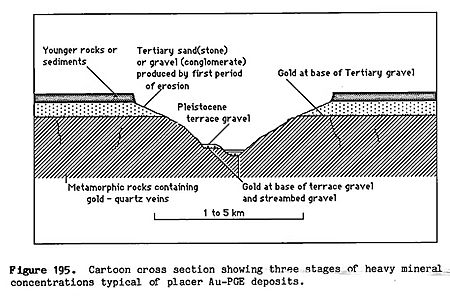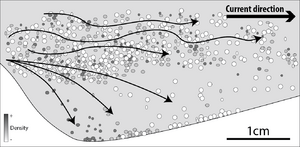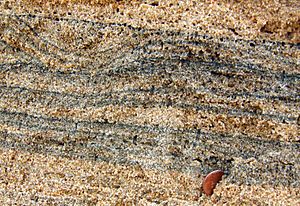Placer deposit facts for kids
A placer deposit is a special collection of valuable minerals. These minerals gather in one spot because of how water and gravity work together. Imagine tiny, heavy treasures getting sorted out from lighter sand and gravel! The word "placer" comes from Spanish and means "alluvial sand," which is sand carried by rivers.
Placer mining is a very old way to find valuable things like gold. It was super important during big gold rushes, like the famous California Gold Rush.
For a placer deposit to form, the minerals need to be both heavy and strong. They must be much heavier than regular sand, which is mostly made of quartz. You often find these deposits with "black sand." This is a shiny, dark mix of iron minerals like magnetite. Other valuable minerals often found with black sand include monazite, rutile, zircon, and cassiterite.
Contents
What Valuable Minerals Are Found in Placers?
Placer deposits are a source for many important minerals. These include:
- Diamonds
- Gold
- Garnet
- Iron, from special sands rich in magnetite
- Platinum group metals (like platinum)
- Rare earth elements, from a mineral called monazite
- Ruby
- Sapphire
- Thorium, also from monazite
- Tin, from the mineral cassiterite
- Titanium, from minerals like ilmenite and rutile
- Uranium, from very old placer deposits
- Zirconium, from the mineral zircon
How Do Placer Deposits Form?
Placer deposits form when valuable minerals are separated from their original rock. This happens through natural processes like weathering and erosion. Water, wind, or ice break down rocks. Then, rivers or ocean waves carry the broken pieces away.
Because the valuable minerals are much heavier, they tend to settle down first. Lighter materials like sand and gravel get carried further away. This natural sorting process concentrates the heavy minerals in specific spots.
Types of Placer Deposits
There are different types of placer deposits, depending on where they form.
River and Stream Placers

These placers form in the sediments of rivers or streams. You often find them in places where the water slows down. Good spots include:
- The inside bends of rivers and creeks.
- Natural hollows or dips in the streambed.
- Where a stream changes slope.
- At the bottom of a waterfall or a steep cliff.
The valuable, heavy particles settle when the water isn't moving fast enough to carry them anymore. This leaves behind a rich deposit of minerals.
Beach Placers
Beach placers form in the sand and gravel along the edges of large bodies of water, like oceans or big lakes. Waves and currents help to sort and concentrate the heavy minerals along the shoreline.
Where Do Diamonds Come From?
Kimberlites are a main source of diamonds. Kimberlites are like long "pipes" of lava that come up from deep inside the Earth. Diamonds form in these deep, hot, and high-pressure conditions.
Once the diamonds are in the kimberlite pipes, they can be weathered out. Then, rivers and streams carry these diamonds away. They get deposited in new locations, forming alluvial diamond deposits. About 10 percent of all diamonds are found in these river-formed placer mines. The famous Witwatersrand Basin in Africa is one such place where many diamonds have been found.
See also
 In Spanish: Placer (geografía) para niños
In Spanish: Placer (geografía) para niños





